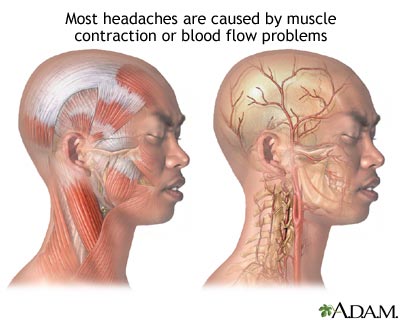What are cranial neuralgias, facial pain, and other headaches?
Neuralgia means nerve pain (neur= nerve + algia=pain). Cranial neuralgia describes a group of headaches that occur because the nerves in the head and upper neck become inflamed and become the source of the pain in the head. Facial pain and a variety of other causes for headache are included in this category.
 What causes tension headaches?
What causes tension headaches?
While tension headaches are the most frequently occurring type of headache, their cause is not known. The most likely cause is contraction of the muscles that cover the skull. When the muscles covering the skull are stressed, they may spasm and cause pain. Common sites include the base of the skull where the trapezius muscles of the neck inserts, the temple where muscles that move the jaw are located, and the forehead.
There is little research to confirm the exact cause of tension headaches. Tension headaches occur because of physical or emotional stress placed on the body. These stressors can cause the muscles surrounding the skull to clench the teeth and go into spasm. Physical stressors include difficult and prolonged manual labor, or sitting at a desk or computer for long periods of time concentrating. Emotional stress may also cause tension headaches by causing the muscles surrounding the skull to contract.
What are the symptoms of tension headaches?
The pain symptoms of a tension headache are:
– The pain begins in the back of the head and upper neck and is described as a band-like tightness or pressure.
– Often is described as pressure encircling the head with the most intense pressure over the eyebrows.
-The pain usually is mild (not disabling) and bilateral (affecting both sides of the head).
– The pain is not associated with an aura (see below), nausea, vomiting, or sensitivity to light and sound.
– The pain occurs sporadically (infrequently and without a pattern) but can occur frequently and even daily in some people.
– The pain allows most people to function normally, despite the headache.
How are tension headaches diagnosed?
The key to making the diagnosis of any headache is the history given by the patient. The health care practitioner will ask questions to understand when the headache began, learn about the quality, quantity, and duration of the pain, and ask about any associated symptoms. The history of tension headache will include pain that is mild to moderate, located on both sides of the head, described as a tightness that is not throbbing, and not made worse with activity. There will be no associated symptoms like nausea, vomiting, or light sensitivity.
The physical examination, particularly the neurologic portion of the examination, is important in tension headaches because it should be normal to make the diagnosis. The only exception is that there may be some tenderness of the scalp or neck muscles. If the health care practitioner finds an abnormality, then the diagnosis of tension headache would not be considered until the potential for other types of headaches have been investigated.
How are tension headaches treated?
Tension headaches are painful, and patients may be upset that the diagnosis is "only" a tension headache. Even though it is not life-threatening, a tension headache can affect the activities of daily life.
Most people successfully treat themselves with over-the–counter (OTC) pain medications to control tension headaches. The following work well for most people:
– aspirin,
– ibuprofen (Motrin, Advil),
– acetaminophen (Tylenol) and
– naproxen (Aleve)
If these fail, other supportive treatments are available. Recurrent headaches should be a signal to seek medical help. Massage, biofeedback, and stress managementcan all be used as adjuncts to help with control of tension headaches.
It is important to remember that OTC medications, while safe, are medications and may have side effects and potential interactions with prescription medications. It always is wise to ask your health care practitioner or pharmacist if you have questions about OTC medications and their use. This is especially important with OTC pain medications, because patients use them so frequently.
It is important to read the listing of ingredients in OTC pain medications. Often an OTC medication is a combination of ingredients, and the second or third ingredient may have the potential for drug interaction or contraindication with medications a patient is currently taking. For example:
- Some OTC medications include caffeine, which may trigger rapid heartbeats in some patients.
- In night time preparations, diphenhydramine (Benadryl) may be added. This may cause drowsiness, and driving or using heavy machinery may not be appropriate when taking the medication.
Other examples where caution should be used include the following:
- Aspirin should not be used in children and teenagers because of the risk ofReye's Syndrome, a disease where coma, brain damage, and death can occur if there is a viral like illness when the and aspirin is used.
- Aspirin and ibuprofen are irritating to the stomach and may cause bleeding. They should be used with caution in patients who have peptic ulcer disease or who take blood thinners like warfarin (Coumadin) and clopidogrel bisulfate (Plavix).
- Acetaminophen, if used in large amounts, can cause liver damage or failure. It should be used with caution in patients who drink significant amounts of alcohol or who have liver disease.
- One cause of chronic tension headaches is overuse of medications for pain. When pain medications are used for a prolonged period of time, headaches can recur as the effects of the medication wear off. Thus, the headache becomes a symptom of the withdrawal of medication (rebound headache).
